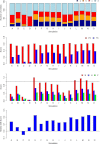Modeling the dispersion of Ambrosia artemisiifolia L. pollen with the model system COSMO-ART
- PMID: 21744099
- PMCID: PMC3382656
- DOI: 10.1007/s00484-011-0468-8
Modeling the dispersion of Ambrosia artemisiifolia L. pollen with the model system COSMO-ART
Abstract
Common ragweed (Ambrosia artemisiifolia L.) is a highly allergenic plant that is spreading throughout Europe. Ragweed pollen can be transported over large distances by the wind. Even low pollen concentrations of less than 10 pollen m(-3) can lead to health problems in sensitive persons. Therefore, forecasting the airborne concentrations of ragweed pollen is becoming more and more important for public health. The question remains whether distant pollen sources need to be considered in reliable forecasts. We used the extended numerical weather prediction system COSMO-ART to simulate the release and transport of ragweed pollen in central Europe. A pollen episode (September 12-16, 2006) in north-eastern Germany was modeled in order to find out where the pollen originated. For this purpose, several different source regions were taken into account and their individual impact on the daily mean pollen concentration and the performance of the forecast were studied with the means of a 2 × 2 contingency table and skill scores. It was found that the majority of the pollen originated in local areas, but up to 20% of the total pollen load came from distant sources in Hungary. It is concluded that long-distance transport should not be neglected when predicting pollen concentrations.
Figures






Similar articles
-
The long distance transport of airborne Ambrosia pollen to the UK and the Netherlands from Central and south Europe.Int J Biometeorol. 2016 Dec;60(12):1829-1839. doi: 10.1007/s00484-016-1170-7. Epub 2016 Apr 27. Int J Biometeorol. 2016. PMID: 27121466 Free PMC article.
-
Mesoscale atmospheric transport of ragweed pollen allergens from infected to uninfected areas.Int J Biometeorol. 2016 Oct;60(10):1493-1500. doi: 10.1007/s00484-016-1139-6. Epub 2016 Feb 2. Int J Biometeorol. 2016. PMID: 26842368 Free PMC article.
-
Heterogeneity in ragweed pollen exposure is determined by plant composition at small spatial scales.Sci Total Environ. 2014 Jul 1;485-486:435-440. doi: 10.1016/j.scitotenv.2014.03.099. Epub 2014 Apr 16. Sci Total Environ. 2014. PMID: 24742553
-
Ragweed is in the Air: Ambrosia L. (Asteraceae) and Pollen Allergens in a Changing World.Curr Protein Pept Sci. 2023;24(1):98-111. doi: 10.2174/1389203724666221121163327. Curr Protein Pept Sci. 2023. PMID: 36411556 Review.
-
Ambrosia artemisiifolia (ragweed) in Germany - current presence, allergological relevance and containment procedures.Allergo J Int. 2015;24:108-120. doi: 10.1007/s40629-015-0060-6. Epub 2015 Jul 11. Allergo J Int. 2015. PMID: 27226949 Free PMC article. Review.
Cited by
-
Atmospheric conditions during high ragweed pollen concentrations in Zagreb, Croatia.Int J Biometeorol. 2012 Nov;56(6):1145-58. doi: 10.1007/s00484-012-0520-3. Epub 2012 Mar 14. Int J Biometeorol. 2012. PMID: 22410823
-
A new approach used to explore associations of current Ambrosia pollen levels with current and past meteorological elements.Int J Biometeorol. 2015 Sep;59(9):1179-88. doi: 10.1007/s00484-014-0929-y. Epub 2014 Nov 7. Int J Biometeorol. 2015. PMID: 25376632
-
Airborne Microalgae: Insights, Opportunities, and Challenges.Appl Environ Microbiol. 2016 Jan 22;82(7):1978-1991. doi: 10.1128/AEM.03333-15. Appl Environ Microbiol. 2016. PMID: 26801574 Free PMC article. Review.
-
Numerical ragweed pollen forecasts using different source maps: a comparison for France.Int J Biometeorol. 2017 Jan;61(1):23-33. doi: 10.1007/s00484-016-1188-x. Epub 2016 Jun 18. Int J Biometeorol. 2017. PMID: 27317399 Free PMC article.
-
Improvement in the accuracy of back trajectories using WRF to identify pollen sources in southern Iberian Peninsula.Int J Biometeorol. 2014 Dec;58(10):2031-43. doi: 10.1007/s00484-014-0804-x. Epub 2014 Apr 5. Int J Biometeorol. 2014. PMID: 24705823
References
-
- Abul-Fatih HA, Bazzaz FA, Hunt R. The biology of Ambrosia trifida L. III. Growth and biomass allocation. New Phytol. 1979;83:829–838. doi: 10.1111/j.1469-8137.1979.tb02314.x. - DOI
-
- Albertenst B, Nawrath S (2006) Verbreitung in Deutschland. InfoPage Beifuß-Ambrosie. http://www.ambrosiainfo.de/53223897640d5c602/index.html. Accessed 15 March 2011
-
- Bangert M, Kottmeier C, Vogel B, Vogel H. Regional scale effects of the aerosol cloud interaction simulated with an online coupled comprehensive chemistry model. Atmos Chem Phys Discuss. 2011;11:1–37. doi: 10.5194/acpd-11-1-2011. - DOI
-
- Belmonte J, Vendrell M, Roure JM, Vidal J, Botey J, Cadahía A. Levels of Ambrosia pollen in the atmospheric spectra of Catalan aerobiological stations. Aerobiologia. 2000;16:93–99. doi: 10.1023/A:1007649427549. - DOI
-
- Bianchi DE, Schwemmin DJ, Wagner WH., Jr Pollen release in the common ragweed (ambrosia artemisiifolia) Bot Gaz. 1959;120:235–243. doi: 10.1086/336030. - DOI
MeSH terms
Substances
LinkOut - more resources
Full Text Sources

